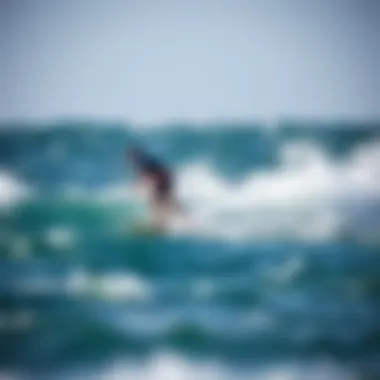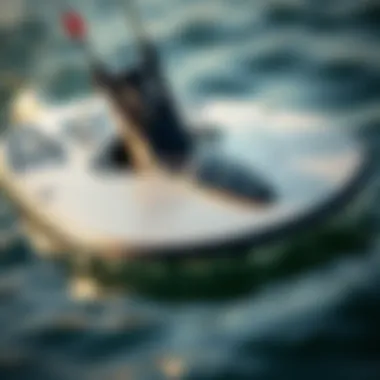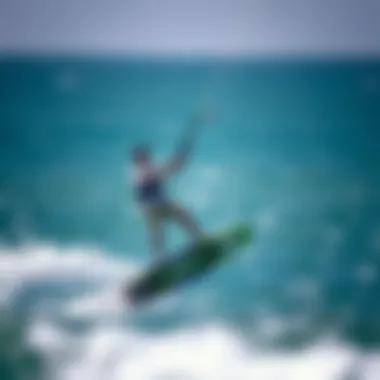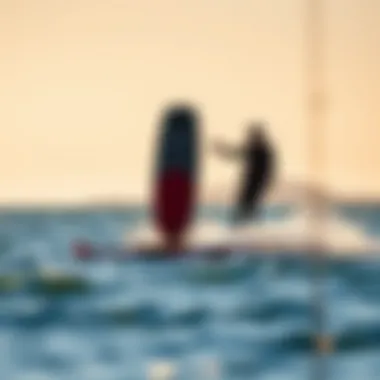The Evolution and Impact of Jetfoil Boards in Kiteboarding


Intro
The world of kiteboarding is a landscape where innovation continually reshapes not only the equipment but also the entire riding experience. Among the tools leading this revolution is the jetfoil board, a marvel of modern design that promises to redefine how enthusiasts—whether novices or seasoned pros—approach the sport.
Jetfoil boards, characterized by their hydrofoil technology, elevate riders above the water's surface, enabling them to reach incredible speeds and perform maneuvers with an impressive level of fluidity. But to understand their significance, it's essential to trace their origins and evolution, delving into how this cutting-edge gear became a staple in the kiteboarding community.
In this journey, we will guide you through the vital aspects of jetfoil boards, examining their design nuances, performance advantages, and the profound impact they have on the kiteboarding landscape. Growth in technology and changing safety considerations play a crucial role, as does the necessity for every kiteboarder to stay informed of emerging trends in this fast-paced sport. So, whether you're looking to elevate your performance or simply understand the hype surrounding jetfoil boards, buckle up as we dive deep into this transformative topic.
Understanding Jetfoil Boards
Jetfoil boards represent a fascinating leap in the world of kiteboarding, blending technology with a thirst for adventure on the water. In this section, we shall delve into what makes these boards stand out, the unique features they offer, and how their design principles are reshaping the riding experience. Understanding jetfoil boards is not just important for seasoned kiteboarders; it opens new paths for newcomers and enthusiasts eager to explore the thrills of riding over water like never before.
To grasp their significance, it’s essential to recognize the fundamental elements of jetfoil boards. These boards are equipped with a specialized hydrofoil beneath that allows riders to lift above the water's surface. This capability minimizes drag, translating to enhanced speeds and smoother rides. Imagine carving through the waves with barely a splash, almost floating on air — that’s the allure of jetfoiling.
Moreover, the benefits of jetfoil boards extend to their versatility in different water conditions. Whether it’s choppy waves or flat waters, these boards can adapt, offering a unique experience that traditional kiteboards simply can’t match. Also, there’s a growing community surrounding jetfoil kiteboarding, filled with passionate riders sharing tips, tricks, and experiences that make entry into this sport ever more appealing.
Basic Design Elements
The design of jetfoil boards is intricate yet elegant. At a glance, these boards may look similar to traditional kiteboards, but a closer inspection reveals their unique attributes. Generally characterized by the following elements:
- Hydrofoil Structure: The defining feature, a hydrofoil, that extends below the board and promotes lift.
- Board Material: Usually crafted from lightweight materials like carbon fiber or advanced composites, ensuring durability without sacrificing performance.
- Shape and Contours: The shape is optimized for water flow, minimizing drag, and maximizing lift, which is crucial for efficient riding.
The combination of these aspects contributes to an experience that is both thrilling and rewarding. As the rider gains confidence and skill, they will discover how these elements enhance their capability to navigate various terrains.
How Jetfoil Technology Works
Understanding how jetfoil technology operates is key to appreciating its impact on kiteboarding. The basic principle revolves around the aerodynamic and hydrodynamic forces at play when a rider is on the board. The hydrofoil acts like an airplane wing, generating lift as it moves through the water.
When a rider gains speed, water flows over the hydrofoil, creating an area of low pressure below it. This pressure difference causes the board to rise above the water surface, typically around a foot or more. The result is a sensation akin to flying, with reduced resistance and increased control. More advanced designs even incorporate adjustable foils which allow for fine-tuning of lift and drag, enhancing the overall riding experience.
Thus, jetfoil technology not only provides a unique aesthetic and sensory experience but also opens the door to thrilling new maneuvers and techniques that are beyond the reach of traditional kiteboarding.
By immersing oneself in the nuances of jetfoil boards, riders can deepen their understanding of this sport, elevating both their skills and their enjoyment on the water.
The History of Jetfoil Boards
The journey of jetfoil boards in kiteboarding is not just an evolution of gear; it mirrors the creativity and advancements in water sports technology over the last few decades. Understanding the history of jetfoil boards helps the reader appreciate not only their significance but also the culmination of engineering expertise and passion that fuels their continued development. This section explores the initial concepts that set the stage for modern jetfoil boards and the technological leaps that have solidified their place in the kiteboarding landscape.
Initial Concepts and Development
Jetfoil boards, though a breakthrough today, began with humble origins. In the mid-20th century, the idea of using hydrofoils—essentially wings that lift a board above the water—was already gaining traction in various water sports. The initial concepts were driven by enthusiasts who wanted to experience smoother rides and greater speed on the water.
By the 1960s, pioneers started experimenting with the design and materials needed to create an effective hydrofoil. Early hydrofoils used in sailing and surfing informed the design of kiteboarding jetfoils, and several inventors were tinkering away in garages, often merging ideas from aerodynamics and buoyancy. This marriage of disciplines led to various designs tested on local waterways. It was a time filled with trial and error, where enthusiasts sometimes found themselves with more exciting wipeouts than successful rides.
The true leap came with advancements in material science in the late 1990s. Boards were becoming lighter, thanks to materials like carbon fiber and improved composites. This facilitated the development of virtually weightless boards that enhanced maneuverability and safety. It was during this pivotal moment that the first proprietary jetfoil kiteboards caught the attention of the kiteboarding community, changing the way many dared to approach the sport.
Evolution Through Technological Advancements
As we entered the 21st century, technology in jetfoil boards took off like a kite in a steady wind. One major advancement was the integration of jet propulsion systems that provided additional thrust. Unlike traditional kiteboards that relied solely on the wind and the rider's skills, jetfoil boards started to cater to a broader audience, even attracting those who were new to the sport or had limited kiteboarding experience.
Some notable advancements included:
- Enhanced Foil Design: The shift towards hydrodynamic shapes allowed for greater efficiency and lift, lifting riders above the water's surface at lower speeds.
- Smart Controllers: Modern boards incorporate sensors that adjust propulsion based on rider input and water conditions, making the experience more intuitive.
- Safety Features: New designs introduced safety innovations such as quick-release systems and better stability in choppy waters, enabling riders to focus more on technique than survival.
"The introduction of jet propulsion in kiteboards wasn't just about going faster; it made the sport accessible to a wider range of enthusiasts eager to experience aerial adventures on water."
The impact of these technologies can't be understated. Around this time, significant competitions began to feature jetfoil boards, further encouraging manufacturers to invest in research and development. As kiteboarding went global, jetfoil boards truly took off, embodying a fusion of performance, safety, and user-friendliness.
This historical perspective is crucial as it underpins the significance of jetfoil boards in today’s kiteboarding scene, setting the stage for the ongoing developments that keep pushing the boundaries of speed, agility, and enjoyment on the water.


Performance Attributes of Jetfoil Boards
When it comes to kiteboarding, performance is the name of the game. Jetfoil boards have taken this performance to a new level, blending cutting-edge technology with the thrill of gliding over water. These boards deliver distinct advantages in speed and maneuverability as well as stability across diverse water conditions. Understanding these attributes helps kiteboarders to leverage the capabilities of jetfoil boards effectively.
Speed and Maneuverability
Jetfoil boards are known for their ability to glide efficiently, achieving remarkable speeds with less effort. Unlike traditional kiteboards, which may require constant paddling or producing force against the water, jetfoil boards essentially "fly" above the water surface. This lift reduces drag, enabling riders to reach higher speeds without the accompanying strain.
The maneuverability of these boards is another standout feature. Riders often find that jetfoils allow for sharper turns and quicker adjustments in direction, resulting in a more exhilarating experience. Unpredictable water currents become less of a challenge, as this board adjusts spontaneously according to the conditions. One rider put it succinctly: "It feels like flying on water. Every twist and turn is so much smoother!"
- Some specific benefits include:
- Quick Acceleration: Even with minimal wind, these boards can get up to speed quickly.
- Precision Control: Riders have better control during tricks and maneuvers.
- Less Resistance: The hydrodynamic design contributes to a sensation of weightlessness.
Stability in Diverse Water Conditions
Jetfoil boards are not just about speed; they also provide unparalleled stability. Whether you’re going through choppy waters or smooth stretches, the design elements ensure that riders maintain control. It’s like having a safety net that cushions against unexpected waves or gusty winds.
The hydrofoil system plays a vital role in enhancing stability. Essentially, when the board rises, it reduces contact with the choppy water surface, helping to avoid the turbulence commonly felt on typical kiteboards. This allows riders to remain balanced, making the experience enjoyable even in less than ideal conditions.
Moreover, versatility is a hallmark of jetfoil boards. They cater to a range of skill attitudes; beginners can stay stable with less risk of falling, while seasoned professionals appreciate the ability to challenge themselves in harsher environments.
- Key stability features include:
- Foiling Technology: Keeps the board above water for a smoother ride.
- Broader Base: Provides a larger footprint for balance.
- Adaptive Design: Boards can handle various sea states without compromising performance.
Safety Considerations for Jetfoil Board Users
Safety is paramount for those engaged in water sports, especially with the increasing popularity of jetfoil boarding. As this thrilling sport gains traction, the importance of understanding safety considerations cannot be overstated. Jetfoil boards function differently than traditional kiteboards, presenting unique challenges and potential hazards. Equip yourself with the right knowledge to enjoy this exhilarating activity safely.
Essential Safety Gear
When it comes to jetfoil boarding, having the proper safety gear is not just advisable—it's crucial. Let's break down the essential equipment that every kiter should consider:
- Life Jacket: A personal flotation device is indispensable. It should fit snugly and not hinder movement.
- Helmet: Protect your head against sudden falls or collisions. Look for helmets designed specifically for water sports.
- Wetsuit or Drysuit: Depending on the water temperature, ensure your suit offers both insulation and protection. A wetsuit offers warmth; a drysuit keeps you completely dry.
- Impact Vest: This additional layer provides cushion against hard landings, allowing you to ride with more confidence.
- Footstraps: Secure footing is essential for maneuverability. Footstraps should be properly fitted to prevent slippage.
While having the right gear won't guarantee that risks vanish, it certainly increases your chances of a safe and enjoyable ride. Never underestimate how crucial these items are!
"One wrong move can change the course of your day; smart gear choices can keep you riding another wave instead of bearing the consequences."
Navigating Hazards in Water Sports
Water sports, inclusive of jetfoil boarding, come with their fair share of risks. Identifying and navigating these hazards is a skill that can save not only your day but also your life. Here are key considerations and tips for staying safe on the water:
- Awareness of Surroundings: Always keep an eye on other riders, boats, and obstacles in the water. Situational awareness is a game changer.
- Weather Conditions: Wind speeds can vary dramatically. Ensure the conditions are appropriate for your skill level and equipment capabilities. Avoid riding during storms or adverse weather.
- Water Depth and Obstacles: Familiarize yourself with the area you'll be riding in. Hidden rocks, sandbars, or floating debris can pose significant threats.
- Proper Launching and Landing Zones: Know where to take off and land safely, away from crowded areas and potential hazards. This not only protects you but others around you.
- Emergency Procedures: Consider keeping a whistle or some signaling device on hand. In distress, getting noticed can be challenging; being prepared may just be a lifesaver.
Managing hazards while jetfoil boarding demands more than just bravado; it requires knowledge, preparation, and respect for the unpredictable nature of the water. By equipping yourself with both the right gear and the right mindset, you can significantly enhance your safety and overall experience in this exciting sport.
For further information on water sports safety regulations, visit Recreation.gov.
For community discussions, check out threads on Reddit or engage with safety tips on Facebook related to kiteboarding.
Comparative Analysis: Jetfoil Boards vs. Traditional Kiteboards
The rise of jetfoil boards has stirred considerable conversation within the kiteboarding community. While traditional kiteboards have long been the norm for riders, newer jetfoil technology introduces a multi-faceted approach to performance and experience on the water. This analysis delves into the significant differences between jetfoil boards and their traditional counterparts, highlighting performance metrics, user feedback, and the overall impact on kiteboarding as a sport.
Performance Metrics
Jetfoil boards work on a principle that substantially alters the dynamics of speed and stability. With the hydrofoil setup beneath the board lifting it above the water, riders can achieve higher speeds, feeling more like flying than surfing at times. Traditional kiteboards, on the other hand, utilize the resistance of water to generate speed, which often leads to more drag, especially in choppy conditions. This results in slower speeds and sometimes a less gratifying experience.
- Speed: Jetfoils can reach speeds upwards of 30 knots, while traditional kiteboards typically peak around 22 knots. This speed advantage is a game changer, especially during races.
- Drag Reduction: The design of jetfoil boards significantly reduces water resistance. This leads to less fatigue for riders who can maintain higher speeds for longer durations without feeling worn out as quickly.
- Maneuverability: Jetfoils provide an agility that traditional boards struggle to match. The ability to pivot and turn quickly enhances the overall riding experience, making it usable even in turbulent waters.


User Experience and Feedback
Feedback from kiteboarders who’ve switched to jetfoil boards paints a vivid picture of changing experiences on the water. Many seasoned users express a sense of liberation as they glide above the elements, relishing the newfound ability to cut through swells and wind without the expected turbulence affecting their ride.
- Hardcore Riders: Experienced kiteboarders report that jetfoils offer a more exhilarating experience. Gliding above the water creates a sensation akin to flying, which some say rekindles the thrill of kiteboarding they felt as beginners.
- Learning Curve: For newcomers, the shift to jetfoil technology can be steep. Many find traditional boards more forgiving and easier to control, particularly when learning the basics of kiteboarding.
- Community Reactions: Discussions vary on platforms like Reddit and kiteboarding forums, where enthusiasts share their stories. Some assert that while jetfoils open new dimensions of riding, they innately come with a higher risk of accidents due to the steep learning curve. Many suggest hybrid boards that can function both as a jetfoil and traditional board to accommodate all skill levels.
In summary, this comparative analysis underlines not just the physical differences between jetfoil and traditional kiteboards, but also reflects a broader evolution in the kiteboarding community. From enhanced performance metrics to varied user experience, the jetfoil is swiftly carving out a significant niche in the water sports arena.
The Future of Jetfoil Boards in Kiteboarding
The future of jetfoil boards in kiteboarding holds substantial promise for the sport. Advancements in technology and changing consumer demands are key drivers of this evolution, which not only aim to enhance the experience for seasoned kiteboarders but also to attract newcomers. With the market steadily expanding, it’s essential to recognize how innovative features, sustainability, and community engagement will shape the trajectory of jetfoil boards moving forward.
In upcoming years, one can expect a fusion of style, function, and environmental considerations in the design of jetfoil boards. Increased awareness about climate change and sustainable practices is compelling gear manufacturers to explore eco-friendly materials and processes. These changes are intended to minimize the ecological footprint while ensuring kiteboarding remains a thrilling activity for future generations.
The incorporation of sustainable materials in manufacturing might not just become a trend but a necessity as consumers lean towards conscious consumerism, creating a win-win for both the planet and the sport.
Innovative Designs on the Horizon
Looking ahead, the design landscape for jetfoil boards is transitioning rapidly. New concepts are emerging that focus on enhanced performance and user accessibility. This includes boards with adaptive hydrofoils that can fine-tune their lift according to the rider’s weight and the water conditions. Imagine a board that can adjust its characteristics in real-time—such a development would revolutionize the way kiteboarders interact with their environment.
Furthermore, brands are experimenting with more lightweight materials that promise better buoyancy and maneuverability. For example, boards made with composite materials can significantly decrease weight while enhancing strength. As these boards evolve, the entire riding experience could shift towards greater agility, enabling riders to perform tricks with more confidence, even in challenging conditions.
Additionally, smart technology is expected to make its way into this riding community. Through integrated sensors, riders might soon have access to real-time data on their speed, balance, and environmental conditions directly on their mobile devices. Not only would this empower kite surfers to enhance their skills, but it could also lead to safer riding experiences.
Predicted Trends in the Kiteboarding Community
As we navigate the future, certain trends are starting to unfold within the kiteboarding community that reflect broader societal shifts. First, we are likely to see an increase in community events and competition formats focused on jetfoil boards. Such competitions could serve as a showcase for emerging talents while also solidifying jetfoil boards' place in the kiteboarding hierarchy.
Moreover, social media platforms are playing a pivotal role in shaping perceptions around kiteboarding. With visually stunning content being shared daily, more people are being drawn to the sport. Trends in the community will likely see an influx of diverse individuals entering the sport, encouraged by easily accessible online resources and forums. This means that fellow enthusiasts will have a broader range of voices contributing to discussions and increasing inclusivity within kiteboarding.
Finally, environmental consciousness will dictate rider preferences. As kiteboarders become more aware of their impact on the oceans, there will be stronger backing for brands that commit to sustainability. This could pave the way for innovations that align leisure with ecological responsibility, challenging traditional notions of performance versus environmental stewardship.
Community Perspectives on Jetfoil Boards
Community insights provide a rich tapestry of understanding regarding the presence and proliferation of jetfoil boards in kiteboarding. This subject is particularly significant as it encapsulates not just the technical aspects of the boards, but how they resonate within the kiteboarding community. Feedback from various users can help illustrate the emerging dynamics, advantages, and obstacles that this innovative equipment introduces. Experienced kiteboarders often share their wisdom regarding optimization, whereas newcomers can reveal the initial hurdles encountered when integrating jetfoil technology into their practice.
Insights from Experienced Kiteboarders
Veteran kiteboarders generally have a goldmine of knowledge, borne of countless hours on the water, and their perspectives on jetfoil boards are invaluable. They often highlight various attributes that are essential for maximizing performance and enjoyment on jetfoils.
- Enhanced Control: Experienced practitioners note that once you get the hang of the jetfoil’s unique riding dynamics, it opens up a new world of control. They describe how subtle adjustments in foot positioning and weight distribution can lead to significant changes in performance.
- Navigating Wind Conditions: According to insights, the jetfoil’s design allows riders to remain more stable in varying wind conditions, an aspect that seasoned users appreciate. Many discuss techniques for harnessing wind power effectively while using jetfoils.
- Community Engagement: Long-time kiteboarders talk about the camaraderie developed around jetfoiling. Clubs and online forums are buzzing with share experiences and tips, fostering a sense of belonging among enthusiasts.
"Once you foil, you're part of a unique club; the thrill of gliding above the water changes everything!"
Newcomers' Impressions and Challenges
For newcomers, jetfoil boards can be both exhilarating and somewhat daunting. Their impressions often focus on the steep initial learning curve associated with learning the mechanics involved. Some common challenges they face include:
- Balance and Coordination: Many newcomers stumble with the balance required to ride jetfoils. Adjusting to the sensation of flying above the water can take considerable practice.
- Safety Awareness: A recurrent concern among new riders is understanding potential risks. Novices might not recognize hazards inherent to jetfoiling and often stress the need for proper safety gear, emphasizing the importance of helmets and impact vests.
- Community Integration: Newcomers frequently discuss feeling like outsiders initially. However, they often express gratitude for the friendly support extended to them as they navigate their new journey within the kiteboarding community. Experienced kiteboarders often advocate for mentorship and share fellow riders’ stories to encourage newer enthusiasts to step confidently onto the boards.
Both experienced riders and newcomers contribute to the evolving narrative around jetfoil boards, showcasing a diverse set of experiences that shape the kiteboarding community. As the sport continues to grow, fostering these perspectives can help address challenges and amplify the excitement surrounding this innovative equipment.
Jetfoil Board Maintenance and Care
Kiteboarding is not just about the thrill of soaring over water; it's also about ensuring that the gear you use is in top condition. Jetfoil boards, known for their innovative design and advanced technology, require specific attention to maintenance and care to guarantee optimum performance and longevity. Without proper upkeep, even the best equipment can falter, which can lead to diminished performance during those high-energy sessions on the water.
Long-term Care for Longevity
To keep a jetfoil board ready for action, a regular maintenance routine is critical. Here are some key practices:


- Rinse After Use: Always rinse your board with fresh water after use in saltwater. Salt can corrode not just the surface but also the internal components, leading to long-term damage.
- Check for Damage: Regularly inspect the board for dings or scratches. Addressing small issues before they escalate can save you time and money. If you find any damage, consider applying waterproof epoxy to repair or seeking professional help.
- Jarage and Storage: When not in use, store your board in a cool, dry place away from direct sunlight. Sun exposure can deteriorate the materials used in modern boards, decreasing their lifespan. Use a padded bag for further protection.
- Educate Yourself: Understanding the materials and construction of your board will help you know the specific care it needs. Some boards are made with carbon fiber, which is lightweight but can be more sensitive to impact compared to plastic compositions.
Taking the time to care for your jetfoil board not only enhances longevity but also maintains performance, so you can enjoy smooth rides without worry.
Troubleshooting Common Issues
Despite diligent care, issues may arise with your jetfoil board, especially as they age or after intensive use. Here are some common problems and the best ways to tackle them:
- Foil Issues: If you notice that your board isn't gaining as much lift, check the foil attachment. Make sure all screws are tight. A loose foil can lead to poor performance and unsafe situations.
- Leaking: If you find water inside your board, it’s a sign that the seal may have been broken. This could be due to impact damage. Dry the board thoroughly and use silicone sealant for repairs. If the problem persists, it's prudent to consult a professional.
- Sticking Mechanism: For adjustable foils, sometimes the mechanism can jam. Ensure that it's clean and well lubricated. Regularly applying a silicone-based lubricant can prevent this problem.
- Fin Stabilization: Should you notice wobbling or instability while riding, inspect the fins for breaks or misalignments. Replacing a damaged fin can dramatically improve ride quality.
In summary, taking maintenance steps and being proactive about troubleshooting can significantly enhance the user experience and longevity of jetfoil boards. This attention to detail cultivates not just gear readiness but also fosters a deeper connection with the kiteboarding experience. By investing time in care, kiteboarders can ensure that every ride is not only exhilarating but also safe.
"A well-maintained board is like a reliable partner on the water—essential to navigating the waves with confidence."
For more about the best practices in kiteboarding and the environment, consider visiting Kiteboarding.com or exploring forums like Reddit's kiteboarding community.
Jetfoil Boards in Competitive Kiteboarding
In the realm of kiteboarding, technological advancements play a pivotal role in enhancing performance and redefining competitive standards. Jetfoil boards, in particular, signify a monumental shift in how enthusiasts partake in this exhilarating sport. These boards are not merely an upgrade; they have ushered in a new era where speed and agility can significantly influence race outcomes. In the following sections, we will analyze the impact of jetfoil technology on race dynamics and discuss how competitors prepare to leverage its benefits.
Impact on Race Dynamics
The introduction of jetfoil boards has notably altered the dynamics of competitive kiteboarding races. With the ability to lift above the water's surface, these boards minimize drag and enhance speed, allowing riders to achieve remarkable velocities. Unlike traditional kiteboards that rely on buoyancy, jetfoils deploy hydrofoils that lift the rider out of the water, creating a sensation akin to flying on water. This transformation brings several advantages:
- Reduced Resistance: The unique design reduces surface area in contact with the water, enabling higher speeds, especially in choppy conditions.
- Improved Agility: Riders can execute sharp turns and rapid acceleration with ease, significantly influencing tactical races.
- Wind Efficiency: Jetfoil boards glide smoothly, harnessing wind power more effectively, leading to longer and faster rides.
Competitors reported that while traditional boards require significant upper body strength to manage board control in high-speed situations, jetfoil boards democratize performance. Riders of varying skill levels can enjoy enhanced capabilities, thus widening access to competing at higher levels.
"The jetfoil board changed the way races are judged. It’s less about strength and more about technique and tactics now," explained a seasoned competitor at a recent championship.
As races become more competitive, understanding the subtleties of jetfoil performance has become essential. This comprehension is especially true when considering the varied environmental conditions competitors might face, adjusting techniques on the fly to use the technology to their advantage.
Training and Preparation for Competitions
To excel in competitions utilizing jetfoil boards, training regimens must accordingly adapt. The approach encompasses several key areas:
- Skill Development: Riders need to familiarize themselves with the unique balance and control required by jetfoils. Unlike traditional kiteboarding, where riders generally rely on their physical strength and stability, jetfoil users must master the subtleties of lift and drag.
- Conditioning: Aerobic and anaerobic fitness are essential. The demands of navigating fast currents, sharp turns, and rapid foam require enhanced physiological readiness.
- Technical Mastery: Learning to execute maneuvers that maximize speed without sacrificing control is crucial. This might include practicing in varied wind conditions to gauge the stability of their boards under different scenarios.
Moreover, understanding competition strategies becomes imperative. Riders are encouraged to study past races, analyze competitors’ techniques, and test different configurations of kite and board setups to identify optimal performance metrics.
As the sport evolves, so does the training landscape, demanding a shift in both mindsets and techniques. Teams are now more likely to include data analysts to refine strategies based on performance trends observed in previous events.
In summary, jetfoil boards have significantly transformed competitive kiteboarding. By reshaping race dynamics and necessitating comprehensive training approaches, these boards are not just a piece of equipment; they are a game changer, enabling competitors to reach new heights both literally and figuratively.
Environmental Considerations of Jetfoil Boards
In recent years, the conversation around sustainable practices has grown louder, especially in sports that heavily interact with the natural environment. Kiteboarding has seen this shift as well, with an increasing focus on how equipment like jetfoil boards can be designed and utilized without causing harm to aquatic ecosystems. This section dives into the nuances of environmental considerations in jetfoil boarding, shedding light on crucial aspects that practitioners and manufacturers need to keep in mind.
Sustainability in Materials and Design
The materials used to construct jetfoil boards play a significant role in their environmental impact. Traditional boards often use fibreglass and polyurethane, which, while effective, are not the most eco-friendly options available. The shift towards sustainable materials, such as recycled plastics and bio-based composites, is vital. Innovations in manufacturing processes can also lead to more energy-efficient production methods, directly reducing the carbon footprint associated with creating jetfoil boards.
When examining the design of these boards, several factors come into play. It’s essential to consider durability; a robust, long-lasting board reduces the need for replacements, thereby minimizing waste. On the flip side, designers increasingly experiment with hydrodynamics to achieve optimal performance without needing aggressive materials or intricate manufacturing techniques. This focus not only benefits the recreational aspect of the sport but also protects the ocean environment, allowing for a more harmonious relationship between enthusiasts and nature.
Conservation Efforts in Kiteboarding
The kiteboarding community has risen to address environmental concerns with various conservation initiatives. Local organizations are at the forefront, actively promoting projects aimed at preserving vulnerable marine habitats. Through awareness campaigns and clean-up events, kiteboarders are stepping up as stewards of the environment. These conservation efforts help maintain healthy ecosystems, which in turn support the very waters where they ride.
Participating in initiatives such as beach clean-ups, educating fellow riders on sustainable practices, and advocating for marine protected areas contribute significantly to conservation. Engaging with local groups and ensuring sustainable practices not only enhances the community’s reputation but also fosters a sense of responsibility toward nature that new kiteboarders can carry with them.
"A clean ocean is a healthy ocean; we ride for the beauty and serenity that our waterways provide."
The rise of ocean conservation organizations aligns closely with the kiteboarding community. Collaboration with scientists and environmental agencies draws on connections between kiteboarding and marine health. By participating in research or funding, these communities can directly contribute to efforts aimed at understanding and mitigating the impacts of climate change on marine life, such as habitat loss and changes to aquatic ecosystems.
In summary, the environmental considerations surrounding jetfoil boards are multifaceted and significant. By adopting sustainable materials and actively supporting conservation efforts, the kiteboarding community not only enhances its sport but demonstrates a commitment to protecting the environments that are crucial to their passion.















